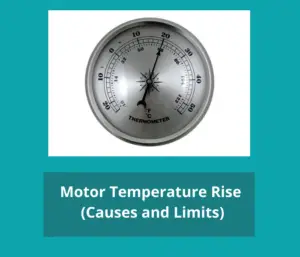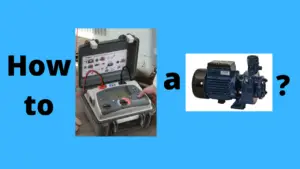| SIngle-Phase Motor | Three-Phase Motor | |
| 1 | Not self-starting (need a starting capacitor) | Self-starting (No starting capacitor) |
| 2 | Lower Power Factor | Higher Power Factor |
| 3 | Need 2 cores cable | Need 3 cores of cable |
| 4 | Consumes more electrical energy | More efficient (Consumes less electrical energy) |
| 5 | Hard to reverse its rotating direction | Easy to reverse its rotating direction |
| 6 | Need higher current protection devices, and larger cable size due to the high current consumption | Draws lower current than the same power rated single phase motor |
In this article, we will discuss what are the differences between single and three-phase motors.
Table of Contents
difference between single-phase and three-phase motor
The key difference between single-phase and three-phase motors lies in the number of phases of the electric power supply that they are designed to operate on.
-
Number of Phases:
- Single-Phase Motor: Operates on a single-phase power supply. Single-phase power is commonly found in residential settings and some small industrial applications.
- Three-Phase Motor: Operates on a three-phase power supply. Three-phase power is more common in industrial and commercial settings, providing more consistent power delivery.
-
Construction and Design:
- Single-Phase Motor: Typically simpler in design and construction compared to three-phase motors. They often have a single winding in the stator.
- Three-Phase Motor: Generally more complex in design. They have three windings in the stator, spaced 120 degrees apart.
-
Starting Mechanism:
- Single-Phase Motor: This may require additional mechanisms for starting, such as a capacitor-start or split-phase design.
- Three-Phase Motor: Typically self-starting, and no additional starting mechanisms are required. They have a rotating magnetic field that initiates motion.
-
Power Delivery and Efficiency:
- Single-Phase Motor: Provides a pulsating torque, which can result in vibration and reduced efficiency, especially in larger applications.
- Three-Phase Motor: Delivers smoother power and constant torque, leading to more efficient operation. This makes three-phase motors preferred for larger industrial applications.
-
Applications:
- Single-Phase Motor: Commonly used in smaller appliances, residential air conditioning units, and other light-duty applications.
- Three-Phase Motor: Commonly used in industrial machinery, heavy-duty equipment, pumps, compressors, and other applications where higher power and efficiency are required.
-
Power Distribution:
- Single-Phase Motor: Found in areas where single-phase power distribution is prevalent, such as residential areas.
- Three-Phase Motor: Commonly used in industrial and commercial settings where three-phase power distribution is more standard.
-
Size and Weight:
- Single-Phase Motor: Generally smaller and lighter compared to three-phase motors, making them suitable for smaller applications.
- Three-Phase Motor: Tends to be larger and heavier, suitable for powering larger equipment and machinery.
Understanding these differences is crucial when selecting a motor for a particular application, as the choice between a single-phase and three-phase motor depends on factors such as power requirements, efficiency, and the availability of the appropriate power supply.
3 phase motor vs single-phase motor power consumption
The power consumption of a motor, whether single-phase or three-phase, is influenced by various factors such as the motor’s design, efficiency, load, and operating conditions.
In general, three-phase motors tend to be more efficient than single-phase motors, especially in larger industrial applications. Here are some considerations regarding power consumption:
-
Efficiency:
- Three-Phase Motor: Three-phase motors are often more efficient than single-phase motors. The balanced and continuous power delivery in three-phase systems results in smoother operation and less power loss.
- Single-Phase Motor: Single-phase motors may have lower efficiency compared to three-phase motors, especially in larger applications.
-
Power Factor:
- Three-Phase Motor: Three-phase motors typically have a higher power factor than single-phase motors. A higher power factor indicates better utilization of electrical power and reduces reactive power, leading to more efficient power consumption.
- Single-Phase Motor: Single-phase motors may have a lower power factor, which can result in less efficient use of electrical power.
-
Size and Application:
- Three-Phase Motor: Three-phase motors are often used in larger industrial applications where higher power requirements and efficiency are crucial. They are suitable for heavy-duty machinery and equipment.
- Single-Phase Motor: Single-phase motors are commonly used in smaller applications and residential settings where lower power requirements are typical.
-
Starting Mechanism:
- Three-Phase Motor: Three-phase motors are often self-starting and do not require additional starting mechanisms. This can contribute to a more efficient power consumption during the starting phase.
- Single-Phase Motor: Depending on the design, single-phase motors may require additional starting mechanisms, which can affect power consumption during startup.
-
Load Type:
- Three-Phase Motor: Three-phase motors are well-suited for handling variable and fluctuating loads. They can maintain efficiency across a range of operating conditions.
- Single-Phase Motor: Single-phase motors may experience reduced efficiency or increased power consumption when subjected to variable or fluctuating loads.
In summary, while the specific power consumption of a motor depends on factors like motor size, design, and efficiency, three-phase motors generally exhibit better efficiency and power factor compared to single-phase motors.
When choosing between single-phase and three-phase motors, it’s important to consider the specific requirements of the application and the availability of the corresponding power supply.
Maintenance of single-phase and three-phase motors
Maintenance practices for both single-phase and three-phase motors are essential to ensure their efficient and reliable operation over time.
While the basic principles of motor maintenance apply to both types, there are some considerations specific to each. Here are general maintenance guidelines for both single-phase and three-phase motors:
Maintenance of Single-Phase Motors:
-
Visual Inspection:
- Regularly inspect the motor for any signs of wear, damage, or overheating.
- Check for loose connections and tighten them as needed.
-
Cleanliness:
- Keep the motor and its surroundings clean to prevent the accumulation of dust and debris.
- Ensure proper ventilation to prevent overheating.
-
Lubrication:
- If the motor has lubrication points, follow the manufacturer’s recommendations for lubrication intervals and use the specified lubricants.
-
Check Insulation:
- Inspect the insulation on wires and windings for signs of wear, aging, or damage.
- Repair or replace any damaged insulation promptly.
-
Capacitor Check (if applicable):
- For motors with capacitors, check the condition of capacitors regularly and replace them if they show signs of bulging or leakage.
-
Alignment:
- Ensure that the motor is properly aligned with the driven equipment to prevent unnecessary wear and vibrations.
Maintenance of Three-Phase Motors:
-
Visual Inspection:
- Regularly inspect the motor for any signs of wear, damage, or overheating.
- Check for loose connections in the control panel and tighten them.
-
Cleanliness:
- Keep the motor and its surroundings clean to prevent the accumulation of dust and debris.
- Ensure proper ventilation to prevent overheating.
-
Lubrication:
- Lubricate bearings according to the manufacturer’s recommendations.
- Follow a regular schedule for bearing maintenance and replacement.
-
Vibration Analysis:
- Conduct vibration analysis regularly to detect any abnormalities that may indicate misalignment or other issues.
-
Power Quality:
- Monitor power quality to ensure a stable and balanced three-phase power supply, as uneven power can affect motor performance and lifespan.
-
Motor Testing:
- Perform routine electrical tests, such as insulation resistance and winding resistance, to assess the motor’s electrical condition.
-
Alignment:
- Ensure that the motor is properly aligned with the driven equipment to prevent unnecessary wear and vibrations.
-
Cooling System:
- If the motor has a cooling system, check and maintain it regularly to ensure efficient heat dissipation.
-
Check Control Devices:
- Inspect and test control devices such as contactors, relays, and overload protection to ensure they are functioning correctly.
-
Regular Overhaul:
- Plan for periodic overhauls or major maintenance, which may include disassembly, cleaning, and inspection of internal components.
General Tips for Both Types:
- Follow the manufacturer’s guidelines for maintenance intervals and procedures.
- Keep records of maintenance activities, including any repairs or replacements.
- Train personnel on proper operating procedures and maintenance tasks.
- If there are unusual sounds, vibrations, or performance issues, investigate and address them promptly.
Regular and proactive maintenance practices can extend the lifespan of both single-phase and three-phase motors, reduce downtime, and contribute to overall system reliability.
Read also:
Why Is A three-phase motor self-starting?
A three-phase motor is self-starting due to the inherent characteristics of the three-phase power supply and the design of the motor itself.
The key factor contributing to the self-starting capability of three-phase motors is the generation of a rotating magnetic field within the motor.
Here’s how the self-starting mechanism works in a three-phase motor:
-
Three-Phase Power Supply:
- A three-phase motor is designed to operate on a three-phase AC power supply. In a three-phase system, three sinusoidal voltages are applied to the motor windings, each phase being offset by 120 degrees from the others.
-
Rotating Magnetic Field:
- When the three-phase power is applied to the stator windings (the stationary part of the motor), it creates a rotating magnetic field.
- The magnetic field rotates because the three phases are offset in time, and the interaction between them generates a magnetic field that appears to move in a circular or rotating manner.
-
Rotor Interaction:
- The rotor (the rotating part of the motor) is placed within this rotating magnetic field. The rotor is typically a set of conductive bars or coils.
- Due to the rotating magnetic field, electromagnetic induction occurs in the rotor, inducing currents in the rotor conductors.
-
Torque Generation:
- The interaction between the rotating magnetic field and the induced currents in the rotor produces torque.
- The torque causes the rotor to start rotating in the same direction as the magnetic field, leading to the self-starting capability of the motor.
-
Synchronization:
- The rotation of the rotor synchronizes with the rotating magnetic field, ensuring that the motor operates efficiently.
The self-starting feature eliminates the need for additional starting mechanisms, such as those commonly required in single-phase motors.
Single-phase motors often require external devices like capacitors or starting windings to create a rotating magnetic field and initiate motion. In contrast, three-phase motors inherently generate a rotating magnetic field, making them self-starting and more robust in many industrial applications.
This self-starting characteristic, along with the efficiency and power factor advantages of three-phase systems, contributes to the widespread use of three-phase motors in various industrial and commercial applications.



